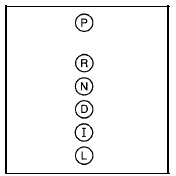Chevrolet Cobalt Owners Manual: Automatic Transmission Operation

If the vehicle has an automatic transmission, the shift lever is located on the console between the seats.
There are several
different positions for the
automatic transmission.
P (Park): This position locks the front wheels. It is the best position to use when starting the engine because the vehicle cannot move easily.
WARNING:
It is dangerous to get out of the vehicle if the shift
lever is not fully in P (Park) with the parking brake
firmly set. The vehicle can roll.
Do not leave the vehicle when the engine is running unless you have to. If you have left the engine running, the vehicle can move suddenly.
You or others could be injured. To be sure the vehicle will not move, even when you are on fairly level ground, always set the parking brake and move the shift lever to P (Park). See Shifting Into Park (Automatic Transmission).
If you are pulling a trailer, see Towing a Trailer (Automatic Transmission) or Towing a Trailer (Manual Transmission).
Make sure the shift lever is fully in P (Park) before starting the engine. The vehicle has an automatic transmission shift lock control system. You have to fully apply the regular brakes first and then press the shift lever button before the vehicle can shift from P (Park) when the ignition key is in ON/RUN. If the vehicle cannot shift out of P (Park), ease pressure on the shift lever and push the shift lever all the way into P (Park) as you maintain brake application. Then press the shift lever button and then move the shift lever into another gear. See Shifting Out of Park (Automatic Transmission).
Notice: Shifting to R (Reverse) while the vehicle is moving forward could damage the transmission.
The repairs would not be covered by the vehicle warranty. Shift to R (Reverse) only after the vehicle is stopped.
R (Reverse): Use this gear to back up.
To rock the vehicle back and forth to get out of snow, ice, or sand without damaging the transmission, see If Your Vehicle is Stuck in Sand, Mud, Ice, or Snow.
N (Neutral): In this position, the engine does not connect with the wheels. To restart the engine when the vehicle is already moving, use N (Neutral) only. Also, use N (Neutral) when the vehicle is being towed.
WARNING:
Shifting into a drive gear while the engine is
running at high speed is dangerous. Unless your
foot is firmly on the brake pedal, the vehicle could
move very rapidly. You could lose control and hit
people or objects. Do not shift into a drive gear
while the engine is running at high speed.
Notice: Shifting out of P (Park) or N (Neutral) with the engine running at high speed may damage the transmission. The repairs would not be covered by the vehicle warranty. Be sure the engine is not running at high speed when shifting the vehicle.
D (Drive): This position is for normal driving with
the automatic transmission. It provides the best fuel
economy. If you need more power for passing and
you are:
- Going less than about 35 mph (55 km/h), push the
accelerator pedal about halfway down.
- Going about 35 mph (55 km/h), push the accelerator all the way down.
Downshifting the transmission in slippery road conditions could result in skidding, see “Skidding” under Loss of Control.
I (Intermediate): This position is also used for normal driving. However, it reduces vehicle speed without using the brakes for slight downgrades where the vehicle would otherwise accelerate due to steepness of grade.
If constant upshifting or downshifting occurs while driving up steep hills, this position can be used to prevent repetitive types of shifts. You might choose I (Intermediate) instead of D (Drive) when driving on hilly, winding roads and when towing a trailer, so that there is less shifting between gears.
L (Low): This position reduces vehicle speed more than I (Intermediate) without actually using the brakes. You can use it on very steep hills, or in deep snow or mud.
If the shift lever is put in L (Low), the transmission will not shift into a low gear until the vehicle is going slowly enough.
Notice: Spinning the tires or holding the vehicle in one place on a hill using only the accelerator pedal may damage the transmission. The repair will not be covered by the vehicle warranty. If you are stuck, do not spin the tires. When stopping on a hill, use the brakes to hold the vehicle in place.
 Engine Coolant Heater
Engine Coolant Heater
The engine coolant heater can provide easier starting
and better fuel economy during engine warm-up in cold
weather condition at or below 0°F (-18°C). Vehicles
with am engine coolant heater shoul ...
 Manual Transmission Operation
Manual Transmission Operation
This is the shift pattern for standard models.
This is the shift pattern for SS models.
Here is how to operate the manual transmission:
Notice: Do not rest your hand on the s ...
See also:
Chevrolet Cobalt Service & Repair Manual. Hood Support Strut, Replace
Warning: Body injury may occur
if no supporting rod is holding hood open when removing hood support strut.
Apply pressure only at end of
hood assist rod for removal or installation. Do not apply pressure to middle
of rod because damage or bending will result.
...
Chevrolet Cobalt Owners Manual
- In Brief
- Seats and Restraint System
- Features and Controls
- Instrument Panel
- Driving Your Vehicle
- Service and Appearance Care
- Maintenance Schedule
- Customer Assistance Information
Chevrolet Cobalt Service Manual
- Air Bags
- Air Conditioning & Heater
- Body & Frame
- Brakes
- Cooling System
- Driveline
- Electrical
- Electronic Stability Controls
- Engine Service
